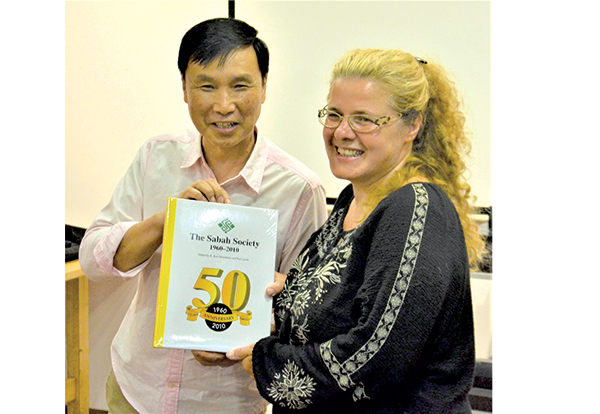Sabah’s history told by a German author
Published on: Sunday, July 28, 2019
By: David Thien

KOTA KINABALU: The Sabah Society recently on July 18, 2019 hosted a talk on Syarif Osman of Marudu by a German lady author Bianca Maria Gerlich.
Syarif Osman was a chieftain in his riverine toll collecting fiefdom of Marudu, in the 1800s, an era before the Chartered Company and its battles against taxation rebel Mat Salleh. Unlike Mat Salleh, there is no portrait painting or photograph of Syarif Osman, believed to be of Arab descent.
ADVERTISEMENT
She published a book entitled, ‘Marudu 1845’. Among those who attended the full house talk at the society’s premises at Damai Plaza was former Chief Minister Datuk Yong Teck Lee.
Yong said after the presentation that he was amazed to have, “as a Sabahan, learn Sabah’s history from a German lady.”
His understanding that the word ‘Marudu’ came from the word ‘Marauder’ (meaning raider, robber, bandit, plunderer, brigand, looter, intruder etc.) was refuted by Bianca Maria Gerlich.
Bianca Maria Gerlich did her research in many places including Sabah and met local people since she started at the School of Oriental and African Studies, London going through the Public Record Office under an Eramus grant.
ADVERTISEMENT
Her interest was heightened after having read Italian novels with accounts about Marudu-like imagination and similar Borneo narrations.
She hopes that one day Syarif Osman’s fort in Marudu can be reconstructed as a museum for preserving the historical significance of the place, being an independent territory that was not part of the territorial claims of the Sultanate of Brunei or Sulu.
ADVERTISEMENT
Bianca Maria Gerlich posits that James Brooke defamed Marudu under head chief Syarif Osman as a pirate’s lair and the latter a pirate chieftain.
“That military action was initiated by James Brooke the Raja of Sarawak, who could only get the support of the Royal Navy by accusing the leader of Marudu, Syarif Osman, of being a pirate.”
She opined that Brooke eliminated a possible rival for his influence over parts of Borneo, which were not yet occupied by other Western powers.
“Syarif Osman had not only built up a strong, economically expanding and independent polity in Marudu Bay, but moreover was in contact with many important leader personalities of the region.
“His far-reaching authority was considered too dangerous by James Brooke.”
“In 1845, Marudu was not only existentially destroyed, but also the memory of it as a coastal state,” she states.
Brunei’s Sultan Omar Ali Saifuddin II and his official Hassim on March 6, 1845 allegedly made an official request to James Brooke for the destruction of Marudu with an estimated population of some 60,000 people after a note from Syarif Osman that Brooke interpreted as a threat. On August 8, the British naval fleet arrived in Brunei with Brooke.
There was a historical account in 1834 (Earl: page 322) that mentioned Marudu under Syarif Osman: “The north-east end of Borneo has not, I believe, been visited by a British vessel since the abandonment of Balambangan, but, according to the accounts of the Bugis traders who sometimes touch there, a very interesting change has lately taken place.
“They assert, that large bodies of Cochin Chinese are now established on the spheres of Malludo Bay and the adjacent parts.”
On August 17, 1845, the naval fleet arrived in Marudu with James Brooke to destroy Marudu. The battle started on August 19 with the marines under Admiral Cochrane, and the fleet left for Manila on August 25 and Brooke returned to Brunei. On Sept 4, Brooke returned to Sarawak.
Another historical account by Blecher in 1848 page 124 states: “At Maludu Bay, in particular, the destruction of Seriff Housman has deprived the people of that region, of the only energetic ruler who could have afforded protection to European traders.
“The natural feeling of enmity towards the nation which has punished them so severely, is likely to continue for some time.”
Keppel in 1851 wrote of his 1848 visit: “… he and the chiefs with him admitted that nothing could be worse than the unprotected state and want of government, under which they lived; that each petty chief quarrelled with and attacked his weaker neighbours, while they, in turn, lived in constant dread of an attack from the more formidable Bajow, or Soloo pirates.”
Could this be reflected in the modern political history of Sabah under part curfew? Mustapha took on Stephens, Stephens disposed Mustapha, Stephens died, Harris took on Mustapha, Pairin disposed Harris, Pairin was disposed and so on until the latest episode Musa was disposed by Shafie. SAPP stalwarts have plenty of reflection time to dwell on the Sabah political creative destruction in which they played a role for renewal promise at their silver jubilee party time.
Sp. St. John in 1862 page 207 wrote after his visit in 1851: “As he (Syarif Osman), being one of those whom they deem invulnerable, exposed himself to every fire, and fought to the last,”
Bianca Maria Gerlich surmised the fall of Marudu in the power-political respects as: “Syarif Osman was mainly a charismatic leader, a Raja, who, using his political, economic and organisation abilities, was about to develop Marudu as a Malay-Bornean maritime coastal state, as his ‘kerajaan’.
Stay up-to-date by following Daily Express’s Telegram channel.
Daily Express Malaysia




